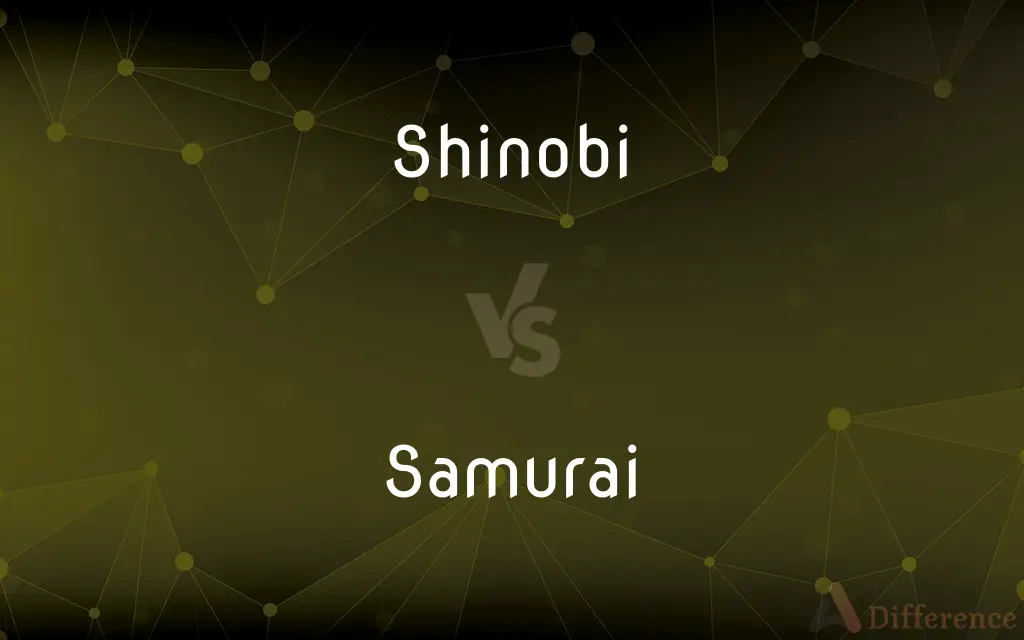Shinobi vs. Samurai — What's the Difference?
Edited by Tayyaba Rehman — By Urooj Arif — Updated on April 25, 2024
Shinobi, often known as ninjas, specialized in espionage and guerrilla warfare, focusing on stealth and deception. Samurai, on the other hand, were military nobility in feudal Japan, adhering to the Bushido code which emphasized honor and combat prowess.

Difference Between Shinobi and Samurai
Table of Contents
ADVERTISEMENT
Key Differences
Shinobi were covert agents who operated under the veil of secrecy, using intelligence and subterfuge as their primary tools. Whereas samurai were highly visible symbols of power and were expected to fight openly and with honor in battles.
Shinobi skills included espionage, sabotage, and assassination, tailored for unorthodox warfare and gathering crucial information. On the other hand, samurai engaged in direct combat, mastering the art of swordsmanship and other martial skills, governed by strict ethical codes.
While the shinobi often came from lower classes or were even non-samurai, utilizing their status to blend into society, samurai typically belonged to the samurai class, wielding significant social and political influence.
Shinobi operated mostly in the shadows, seldom receiving public recognition for their services, which were critical in warfare and intelligence. In contrast, samurai were celebrated figures in Japanese history and culture, often glorified in literature and arts.
Despite their differing roles and methods, both shinobi and samurai were essential to the military strategies of their lords, illustrating the complex social and military structure of feudal Japan.
ADVERTISEMENT
Comparison Chart
Primary Role
Espionage and guerrilla warfare
Military nobility and combat
Social Class
Often lower or non-samurai
Samurai class
Recognition
Operated secretly, rarely recognized publicly
Highly visible and celebrated
Combat Techniques
Stealth tactics, sabotage
Direct combat, swordsmanship
Ethical/Moral Code
Flexibility in methods, deception encouraged
Bushido code, emphasizing honor and loyalty
Compare with Definitions
Shinobi
Trained in the arts of stealth and sabotage.
The shinobi silently infiltrated the castle under the cover of night.
Samurai
Trained in martial arts and swordsmanship.
From a young age, the samurai was skilled in the art of the katana.
Shinobi
Skilled in various forms of unconventional warfare.
Employing smoke bombs, the shinobi created a diversion to escape.
Samurai
Often romanticized in literature and films.
The film portrayed the samurai as a heroic figure, embodying strength and honor.
Shinobi
Often hired for assassination and gathering intelligence.
A shinobi was hired to assassinate a key political figure discreetly.
Samurai
Held significant social and political power.
The samurai attended the council meeting, his input crucial in the war strategy.
Shinobi
A member of a covert group primarily tasked with espionage.
A shinobi was sent to gather intelligence on the enemy’s movements.
Samurai
Known for their loyalty and ethical conduct.
The samurai displayed unmatched loyalty to his lord, even at the cost of his life.
Shinobi
Utilized tools like shuriken and grappling hooks.
The shinobi used a grappling hook to scale the fortress walls.
Samurai
A warrior class in feudal Japan, adhering to the Bushido code.
The samurai prepared for battle, his honor guiding his every move.
Shinobi
A male ninja.
Samurai
Samurai (侍) were the hereditary military nobility and officer caste of medieval and early-modern Japan from the late 12th century to their abolition in 1876. They were the well-paid retainers of the daimyo (the great feudal landholders).
Samurai
The Japanese feudal military aristocracy.
Samurai
A professional warrior belonging to this class.
Samurai
In feudal Japan, a soldier who served a daimyo.
Samurai
In the former feudal system of Japan, the class or a member of the class, of military retainers of the daimios, constituting the gentry or lesser nobility. They possessed power of life and death over the commoners, and wore two swords as their distinguishing mark. Their special rights and privileges were abolished with the fall of feudalism in 1871. They were referred to as "a cross between a knight and a gentleman".
Samurai
A Japanese warrior who was a member of the feudal military aristocracy
Samurai
Feudal Japanese military aristocracy
Common Curiosities
What were the primary functions of a shinobi?
Shinobi were primarily involved in espionage, intelligence gathering, and sabotage.
How did samurai differ from shinobi in combat?
Samurai engaged in open combat following a strict ethical code, while shinobi used stealth and were flexible in their methods.
Did shinobi follow any particular code like the samurai’s Bushido?
Unlike samurai, shinobi did not have a formal code but were guided by the practical needs of their secretive missions.
Could a samurai also be a shinobi?
While uncommon, there were instances where samurai performed espionage tasks, but typically these roles were distinct.
What tools did shinobi typically use?
Shinobi used tools like shuriken (throwing stars), grappling hooks, and smoke bombs.
How did the lifestyles of shinobi and samurai differ?
Shinobi led secretive lives with a focus on their missions, while samurai had more public and structured lives with clear social roles.
How were shinobi perceived in Japanese society compared to samurai?
Shinobi were often viewed as necessary but secretive, operating in the shadows, unlike the highly respected samurai class.
What type of training did samurai receive?
Samurai training focused on martial arts, swordsmanship, and strategic military tactics.
Did shinobi and samurai ever work together?
Yes, in certain military campaigns, shinobi and samurai worked together, with shinobi gathering intelligence and samurai leading the combat.
Were there female shinobi or samurai?
Yes, there were female operatives known as kunoichi among the shinobi and onna-bugeisha among the samurai.
How did the roles of shinobi and samurai evolve over time?
Both roles evolved with the changing dynamics of warfare and society in Japan, with samurai becoming more bureaucratic over time while shinobi faded as Japan modernized.
What were the ethical implications of a shinobi’s methods?
Shinobi’s methods often raised ethical questions due to their reliance on deceit and assassination.
What kind of armor did samurai wear?
Samurai wore elaborate armor designed for protection in battle, including helmets and body armor.
How are shinobi and samurai depicted in popular culture?
Both are popular figures in media, with shinobi often shown as mysterious and stealthy, and samurai as honorable and skilled warriors.
What was the social status of shinobi?
Shinobi generally had lower social status compared to samurai and were often non-samurai or from lower classes.
Share Your Discovery

Previous Comparison
Capricious vs. Cruel
Next Comparison
Coalfish vs. PollockAuthor Spotlight
Written by
Urooj ArifUrooj is a skilled content writer at Ask Difference, known for her exceptional ability to simplify complex topics into engaging and informative content. With a passion for research and a flair for clear, concise writing, she consistently delivers articles that resonate with our diverse audience.
Edited by
Tayyaba RehmanTayyaba Rehman is a distinguished writer, currently serving as a primary contributor to askdifference.com. As a researcher in semantics and etymology, Tayyaba's passion for the complexity of languages and their distinctions has found a perfect home on the platform. Tayyaba delves into the intricacies of language, distinguishing between commonly confused words and phrases, thereby providing clarity for readers worldwide.














































